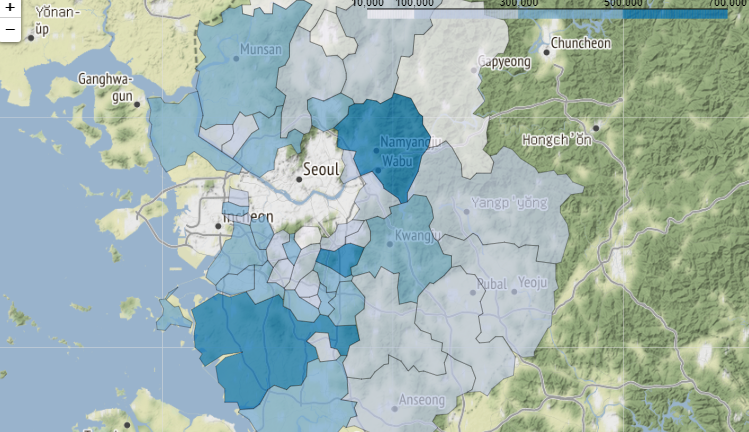
4. 시각화 도구
1) Matplotlib - 기본 그래프 도구
1-1 선 그래프
- 기본 사용법
matplotlib.pyplot as pltdf.fillna(method='ffill')- 누락 데이터가 들어 있는 행의 바로 앞에 위치한 행의 데이터 값으로 채움
plt.plot(x축, y축)plt.plot(시리즈 or 데이터프레임 객체)
df = df.fillna(method='ffill')
# 서울에서 다른 지역으로 이동한 데이터만 추출
condition = (df['전출지별'] == '서울특별시') & (df['전입지별'] != '서울특별시')
df_seoul = df[condition]
df_seoul.drop(['전출지별'], axis=1)
df_seoul.rename({'전입지별':'전입지'}, axis=1, inplace=True)
df_seoul.set_index('전입지', inplace=True)
- 차트 제목, 축 이름 추가
plt.title(): 차트 제목 추가plt.xlabel(): x축 이름plt.ylabel(): y축 이름
Matplotlib 한글 폰트 오류 해결
# matplotlib 한글 폰트 오류 문제 해결
from matplotlib import font_manager, rc
font_path = "C:\Windows\\Fonts\\malgun.ttf" #폰트파일의 위치
font_name = font_manager.FontProperties(fname=font_path).get_name()
rc('font', family=font_name)그래프 꾸미기
plt.figure(figsize=(가로,세로)): 그림틀 사이즈plt.xticks(): x축 눈금 라벨을 반시계 방향으로 회전plt.xticks(rotation='vertical'): 반시계방향으로 90도 회전
plt.style.use('ggplot'): ggplot 스타일 서식 지정plt.style.available>> 스타일 리스트
plt.plot(marker='o', markersize=10): 원 모양의 점 마커로 표시, 마커 사이즈
plt.figure(figsize=(10,6))
plt.plot(sr_one.index, sr_one.values, marker='o', markersize=10) # 마커 표시 # 마커 사이즈
plt.title('서울 >> 경기 인구 이동') # 차트제목
plt.xlabel('기간')
plt.ylabel('이동 인구수')
plt.legend(labels=['서울 >> 경기'], loc='best', fontsize=15)
plt.xticks(rotation = 90)
plt.show()
annotate(): 그래프에 대한 설명을 덧붙이는 주석arrowprops옵션 : 화살표 표시
plt.figure(figsize=(10,6))
plt.plot(sr_one.index, sr_one.values, marker='o', markersize=10)
plt.title('서울 >> 경기 인구 이동')# 제목
plt.xlabel('기간')
plt.ylabel('이동 인구수')
plt.legend(labels=['서울 >> 경기'], loc='best', fontsize=15)
plt.xticks(rotation = 90)
# 주석 남기기
# y축 범위 지정 (최소값, 최대값)
plt.ylim(50000, 800000)
# 주석 표시 - 화살표
plt.annotate('',
xy=(20, 620000), #화살표의 머리 부분(끝점)
xytext=(2, 290000), #화살표의 꼬리 부분(시작점)
xycoords='data', #좌표체계
arrowprops=dict(arrowstyle='->', color='skyblue', lw=5), #화살표 서식
)
plt.annotate('',
xy=(47, 450000), #화살표의 머리 부분(끝점)
xytext=(30, 580000), #화살표의 꼬리 부분(시작점)
xycoords='data', #좌표체계
arrowprops=dict(arrowstyle='->', color='olive', lw=5), #화살표 서식
)
# 주석 표시 - 텍스트
plt.annotate('인구이동 증가(1970-1995)', #텍스트 입력
xy=(10, 550000), #텍스트 위치 기준점
rotation=25, #텍스트 회전각도
va='baseline', #텍스트 상하 정렬
ha='center', #텍스트 좌우 정렬
fontsize=15, #텍스트 크기
)
plt.annotate('인구이동 감소(1995-2017)', #텍스트 입력
xy=(40, 560000), #텍스트 위치 기준점
rotation=-11, #텍스트 회전각도
va='baseline', #텍스트 상하 정렬
ha='center', #텍스트 좌우 정렬
fontsize=15, #텍스트 크기
)
plt.show()
화면 분할하여 그래프 여러 개 그리기 - ==axe 객체 활용==
fig.add_subplot()메소드 : 그림틀 여러 개로 분할 >> 각 부분을axe객체라 부름- fig.add_subplot(2,1,1) : 2행 1열 1번째 부분
sr_one = df_seoul.loc['경기도'][1:]
# 스타일 서식
plt.style.use('ggplot')
# 그래프 객체 생성(2개의 sub plot 생성)
fig = plt.figure(figsize=(10,10))
ax1 = fig.add_subplot(2,1,1)
ax2 = fig.add_subplot(2,1,2)
# axe 객체에 plot 함수로 그래프 출력
ax1.plot(sr_one, marker='o', markersize=10)
ax2.plot(sr_one, marker='o', markerfacecolor='green', markersize=10,
color='olive', linewidth=2, label='서울 >> 경기')
ax2.legend(loc='best')
# y축 범위 지정
ax1.set_ylim(50000, 800000)
ax2.set_ylim(50000, 800000)
# 축 눈금 라벨 지정
ax1.set_xticklabels(sr_one.index, rotation=75)
ax2.set_xticklabels(sr_one.index, rotation=75)
plt.show()
- 선 그래프 꾸미기 옵션
| 꾸미기 옵션 | 설명 |
|---|---|
| 'o' | 선 그래프가 아니라 점 그래프로 표현 |
| marker='o' | 마커 모양(예 : 'o', '+', '*', '.') |
| markerfacecolor='green' | 마커 배경색 |
| markersize=10 | 마커 크기 |
| color='olive' | 선의 색 |
| linewidth=2 | 선의 두께 |
| label='서울 -> 경기' | 라벨 지정 |
동일한 그림(axe 객체)에 여러 개의 그래프 추가
# 전출지별에서 누락값(NaN)을 앞 데이터로 채움 (엑셀 양식 병합 부분)
df = df.fillna(method='ffill')
# 서울에서 다른 지역으로 이동한 데이터만 추출하여 정리
condition = (df['전출지별'] == '서울특별시') & (df['전입지별'] != '서울특별시')
df_seoul = df[condition]
df_seoul = df_seoul.drop(['전출지별'], axis=1)
df_seoul.rename({'전입지별':'전입지'}, axis=1, inplace=True)
df_seoul.set_index('전입지', inplace=True)
# 서울에서 '충청남도','경상북도', '강원도'로 이동한 인구 데이터 값만 선택
col_years = list(map(str, range(1970, 2018)))
df_3 = df_seoul.loc[['충청남도','경상북도', '강원도'], col_years]
# 스타일 서식 지정
plt.style.use('ggplot')
# 그래프 객체 생성 (figure에 1개의 서브 플롯을 생성)
# plt.figure(figsize=(20, 5))
fig = plt.figure(figsize=(20, 5))
ax = fig.add_subplot(1, 1, 1)
# axe 객체에 plot 함수로 그래프 출력
ax.plot(col_years, df_3.loc['충청남도',:], marker='o', markerfacecolor='green',
markersize=10, color='olive', linewidth=2, label='서울 -> 충남')
ax.plot(col_years, df_3.loc['경상북도',:], marker='o', markerfacecolor='blue',
markersize=10, color='skyblue', linewidth=2, label='서울 -> 경북')
ax.plot(col_years, df_3.loc['강원도',:], marker='o', markerfacecolor='red',
markersize=10, color='magenta', linewidth=2, label='서울 -> 강원')
# 범례 표시
ax.legend(loc='best')
# 차트 제목 추가
ax.set_title('서울 -> 충남, 경북, 강원 인구 이동', size=20)
# 축이름 추가
ax.set_xlabel('기간', size=12)
ax.set_ylabel('이동 인구수', size = 12)
# 축 눈금 라벨 지정 및 90도 회전
ax.set_xticklabels(col_years, rotation=90)
# 축 눈금 라벨 크기
ax.tick_params(axis="x", labelsize=10)
ax.tick_params(axis="y", labelsize=10)
plt.show() # 변경사항 저장하고 그래프 출력화면 4분할 그래프
# 전출지별에서 누락값(NaN)을 앞 데이터로 채움 (엑셀 양식 병합 부분)
df = df.fillna(method='ffill')
# 서울에서 다른 지역으로 이동한 데이터만 추출하여 정리
condition = (df['전출지별'] == '서울특별시') & (df['전입지별'] != '서울특별시')
df_seoul = df[condition]
df_seoul = df_seoul.drop(['전출지별'], axis=1)
df_seoul.rename({'전입지별':'전입지'}, axis=1, inplace=True)
df_seoul.set_index('전입지', inplace=True)
# 서울에서 '충청남도','경상북도', '강원도'로 이동한 인구 데이터 값만 선택
col_years = list(map(str, range(1970, 2018)))
df_4 = df_seoul.loc[['제주특별자치도','충청남도','경상북도', '강원도'], col_years]
# 스타일 서식 지정
plt.style.use('ggplot')
# 그래프 객체 생성 (figure에 1개의 서브 플롯을 생성)
fig = plt.figure(figsize=(20, 10))
ax1 = fig.add_subplot(2, 2, 1)
ax2 = fig.add_subplot(2, 2, 2)
ax3 = fig.add_subplot(2, 2, 3)
ax4 = fig.add_subplot(2, 2, 4)
# axe 객체에 plot 함수로 그래프 출력
ax1.plot(col_years, df_4.loc['제주특별자치도',:], marker='o', markerfacecolor='orange',
markersize=10, color='olive', linewidth=2, label='서울 -> 제주')
ax2.plot(col_years, df_4.loc['충청남도',:], marker='o', markerfacecolor='green',
markersize=10, color='olive', linewidth=2, label='서울 -> 충남')
ax3.plot(col_years, df_4.loc['경상북도',:], marker='o', markerfacecolor='blue',
markersize=10, color='skyblue', linewidth=2, label='서울 -> 경북')
ax4.plot(col_years, df_4.loc['강원도',:], marker='o', markerfacecolor='red',
markersize=10, color='magenta', linewidth=2, label='서울 -> 강원')
# 범례 표시
ax1.legend(loc='best')
ax2.legend(loc='best')
ax3.legend(loc='best')
ax4.legend(loc='best')
# 차트 제목 추가
ax1.set_title('서울 -> 제주특별자치도 인구 이동', size=15)
ax2.set_title('서울 -> 충남 인구 이동', size=15)
ax3.set_title('서울 -> 경북 인구 이동', size=15)
ax4.set_title('서울 -> 강원 인구 이동', size=15)
# 축이름 추가
ax.set_xlabel('기간', size=12)
ax.set_ylabel('이동 인구수', size = 12)
# 축 눈금 라벨 지정 및 90도 회전
ax1.set_xticklabels(col_years, rotation=90)
ax2.set_xticklabels(col_years, rotation=90)
ax3.set_xticklabels(col_years, rotation=90)
ax4.set_xticklabels(col_years, rotation=90)
# 축 눈금 라벨 크기
ax.tick_params(axis="x", labelsize=10)
ax.tick_params(axis="y", labelsize=10)
plt.show() # 변경사항 저장하고 그래프 출력
- Matplotlib에서 사용할 수 있는 색의 종류
colors={}
for name, hex in matplotlib.colors.cnames.items():
colors[name] = hex
colors1-2 면적 그래프
plot(kind='area'): 면적 그래프(area plot)alpha: 투명도 (0~1 범위)stacked=True: 그래프를 누적할지 여부stacked=False: 누적되지 않고 서로 겹치도록 표시됨
# 서울에서 '충청남도','경상북도', '강원도'로 이동한 인구 데이터 값만 선택
col_years = list(map(str, range(1970, 2018)))
df_4 = df_seoul.loc[['제주특별자치도','충청남도','경상북도', '강원도'], col_years]
tdf_4 = df_4.T
# 데이터프레임의 인덱스를 정수형으로 변경(x축 눈금 라벨 표시)
tdf_4.index = tdf_4.index.map(int)
# 면적 그래프 그리기
tdf_4.plot(kind='area', stacked=True, alpha=0.2, figsize=(20, 10))
plt.title('서울 -> 타시도 인구 이동', size=30, color='brown', weight='bold')
plt.ylabel('이동 인구 수', size=20, color='blue')
plt.xlabel('기간', size=20, color='blue')
plt.legend(loc='best', fontsize=20)
plt.show()
# stacked=True
# 선 그래프가 서로 겹치지 않고 위 아래로 데이터가 누적(stacked)되는 면적 그래프
# stacked=False (반대임)- stacked=True (그래프 누적)
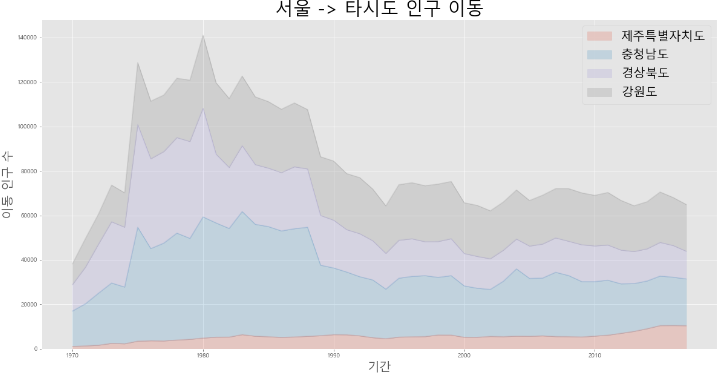
- Stacked=False (그래프 겹침)

1-3 막대 그래프
plot(kind='bar'): 막대 그래프 (bar plot)- 세로형 막대 그래프 : 시간적으로 차이가 나는 두 점에서 데이터 값 차이를 잘 설명함
- 시계열 데이터 표현하는 데 적합
color: 막대 색상을 다르게 설정
tdf_4.plot(kind='bar', figsize=(20,10), width=0.7,
color=['orange','green','skyblue','yellow'])
plt.ylabel('이동 인구 수', size=20)
plt.xlabel('기간', size=20)
plt.ylim(5000, 30000)
plt.legend(loc='best', fontsize=15)
plt.show()
- 가로형 막대 그래프 : 각 변수 사이 값의 크기 차이를 설명하는 데 적합
plot(kind='barh')
# 인구 수 합계하여 새로운 열로 추가
df_4['합계'] = df_4.sum(axis=1)
# 가장 큰 값부터 정렬
df_total = df_4[['합계']].sort_values(by='합계', ascending=True)
# ascending=True 오름차순
# ascending=False 내림차순
# 스타일 서식 지정
plt.style.use('ggplot')
# 수평 막대 그래프 그리기
df_total.plot(kind='barh', color='cornflowerblue', width=0.5, figsize=(10,5))
plt.title('서울 -> 타시도 인구 이동')
plt.ylabel('전입지')
plt.xlabel('이동 인구 수')
plt.show()

- 2축 그래프 그리기
shift(): 데이터를 1행씩 뒤로 이동ax.twinx(): ax 객체의 쌍둥이 객체를 만들고, 쌍둥이 객체를 ax2에 저장ls='--': 선 스타일(line style) 점선으로 설정하는 명령
# 증감률(변동률) 계산
df = df.rename(columns={'합계':'총발전량'})
df['총발전량 - 1년'] = df['총발전량'].shift(1)
df['증감율'] = ((df['총발전량'] / df['총발전량 - 1년']) - 1) * 100 # 2축 그래프 그리기
ax1 = df[['수력','화력']].plot(kind='bar', figsize=(20, 10), width=0.7, stacked=True)
# 수력, 화력 bar graph
ax2 = ax1.twinx() # ax2 : 증감율 그래프
ax2.plot(df.index, df.증감율, ls='--', marker='o', markersize=20,
color='green', label='전년대비 증감율(%)')
ax1.set_ylim(0, 500)
ax2.set_ylim(-50, 50)
ax1.set_xlabel('연도', size=20)
ax1.set_ylabel('발전량(억 KWh)')
ax2.set_ylabel('전년 대비 증감율(%)')
plt.title('북한 전력 발전량 (1990 ~ 2016)', size=30)
ax1.legend(loc='best')
plt.show()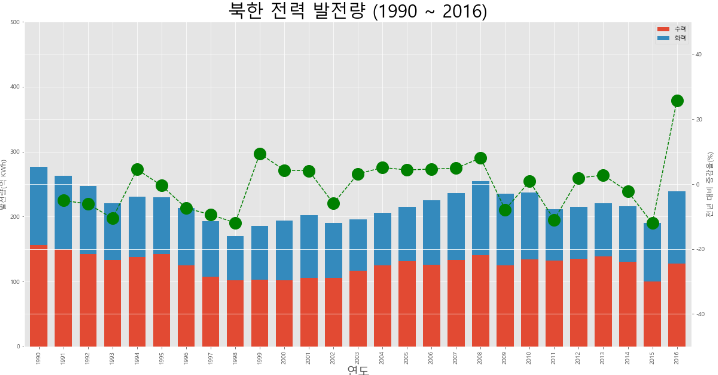
1-4 히스토그램
plot(kind='hist'): 히스토그램(histogram)plot(kind='hist', bins=10): 10개 구간으로 나눔- x축을 같은 크기의 여러 구간으로 나누고 각 구간에 속하는 데이터 값의 개수(빈도)를 y축에 표시
df['mpg'].plot(kind='hist', bins=10, color='coral', figsize=(10,5))
plt.title('auto_histogram')
plt.xlabel('mpg')
plt.show()
1-5 산점도
plot(kind='scatter'): 산점도(scatter plot)- 서로 다른 두 변수 사이의 관계를 나타냄
- 각 변수는 연속되는 값
- 정수형(int64) 또는 실수형(float64)
- 2개의 연속 변수를 각각 x축과 y축에 하나씩 놓고, 데이터 값이 위치하는 (x,y) 좌표를 찾아서 점으로 표시
c= 점의 색상(color)s= 점의 크기(size)
# scatter plot
df.plot(kind='scatter', x='weight', y='mpg', c='coral', s=10, figsize=(10,5))
plt.title('scatter_plot_auto')
plt.show()
plot(kind='scatter'): 버블(bubble) 차트- 실린더 개수를 나타내는 정수를 그대로 쓰는 대신, 해당 열의 최대값 대비 상대적 크기를 나타내는 비율
- 0~1 범위의 실수 값 배열(시리즈)
s= 해당 열의 최댓값 대비 상대적 크기를 나타내는 비율 >> 점의 크기
# cylinders 개수의 상대적 비율을 계산하여 시리즈 생성
cylinder_size = df.cylinders / df.cylinders.max() * 100
# 3개의 변수로 산점도 그리기
df.plot(kind='scatter', x = 'weight', y='mpg', c='blue', s=cylinder_size,
figsize=(10,5), alpha=0.3)
plt.title('bubble_chart: mpg - weight - cylinders')
plt.show()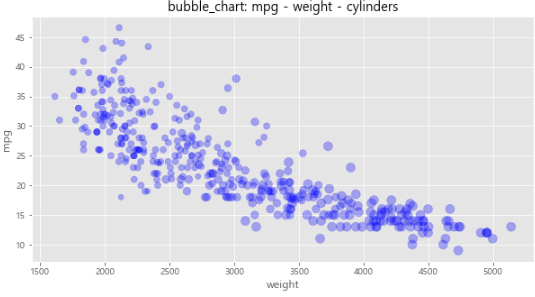
그래프를 그림 파일로 저장
transparent=True: 그림 배경을 투명하게 지정plt.savefig(): 그림 파일 저장marker='+': 점의 모양을 십자(+)로 표시c옵션으로 값에 따라 다른 색상으로 표현cmap = viridis: 색상을 정하는 컬러맵(cmap)
cylinder_size = df.cylinders / df.cylinders.max() * 100
# 3개의 변수로 산점도 그리기
df.plot(kind='scatter', x='weight', y='mpg', marker='+', figsize=(10, 5),
cmap='viridis', c=cylinder_size, s=50, alpha=0.3)
plt.title('Scatter Plot: mpg-weight-cylinders')
plt.savefig("./scatter.png")
plt.savefig("./scatter_transparent.png", transparent=True)
# transparent=True 그림의 배경을 투명하게 해줄까요? True
plt.show()1-6 파이 차트
plot(kind='pie'): 파이 차트(pie chart)- 원을 파이 조각처럼 나누어서 표현
- 조각의 크기는 해당 변수에 속하는 데이터 값의 크기에 비례
%1.1f%%: 숫자를 퍼센트(%)로 나타내는데, 소수점 이하 첫째자리까지 표기
df_origin['count'].plot(kind='pie',
figsize = (7,5),
autopct = '%1.1f%%', # percent 표시
startangle=90,
colors=['chocolate', 'bisque', 'red']
)
plt.title('Auto_model Origin', size=20)
plt.axis('equal')
plt.legend(labels = df_origin.index, loc='best')
plt.show()
1-7 박스 플롯

axe.boxplot(): 박스플롯(box plot)figure(figsize=(가로,세로)): 그림틀 가로, 세로 설정add_subplot():axe객체로 분할labels: 각 열을 나타내는 라벨 정의vert=False수평 박스 플롯
# boxplot()
# 스타일 서식 지정
plt.style.use('seaborn-poster')
plt.rcParams['axes.unicode_minus']=False # 마이너스 부호 출력 설정
fig = plt.figure(figsize=(10,6))
ax1 = fig.add_subplot(1,2,1)
ax2 = fig.add_subplot(1,2,2)
# axe 객체에 boxplot 메소드로 그래프로 출력
ax1.boxplot(x = [df[df['origin'] == 1]['mpg'],
df[df['origin'] == 2]['mpg'],
df[df['origin'] == 3]['mpg'],
], labels=['USA','EU','KOREA'])
ax2.boxplot(x = [df[df['origin'] == 1]['mpg'],
df[df['origin'] == 2]['mpg'],
df[df['origin'] == 3]['mpg'],
], labels=['USA','EU','KOREA'],
vert=False) # vert >> veritical 수직의
ax1.set_title('제조국적별 연비 분포(수직)')
ax2.set_title('제조국적별 연비 분포(수평)')
plt.show()
파이썬 그래프 갤러리 여기 참고
2) Seaborn 라이브러리 - 고급 그래프 도구
import seaborn as sns
회귀선이 있는 산점도
regplot(): 회귀선이 있는 산점도- 서로 다른 2개의 연속 변수 사이의 산점도를 그리고 선형회귀분석에 의한 회귀선을 함께 나타냄
fit_reg=False: 회귀선 안 보이게
fig = plt.figure(figsize=(15,5))
ax1 = fig.add_subplot(1,2,1)
ax2 = fig.add_subplot(1,2,2)
# 선형회귀선 표시(regplot)
sns.regplot(x='age',
y='fare',
data=titanic,
ax = ax1)
sns.regplot(x='age',
y='fare',
data=titanic,
ax = ax2,
fit_reg=False) # 회귀선 미표시
plt.show()
히스토그램/커널 밀도 그래프
sns.histplot(): 히스토그램/커널 밀도 그래프- 단변수(하나의 변수) 데이터의 분포를 확인
hist=False: 히스토그램이 표시되지 않음kde=False: 커널 밀도 그래프를 표시하지 않음
# histplot()
# 그래프 객체 생성 (figure에 3개의 서브 플롯을 생성)
fig = plt.figure(figsize=(15, 5))
ax1 = fig.add_subplot(1, 2, 1)
ax2 = fig.add_subplot(1, 2, 2)
sns.histplot(titanic['fare'],ax=ax1)
sns.histplot(titanic['fare'],kde=True, ax=ax2)
# kde : kernel density estimation >> 정규분포
ax1.set_title('titanic_fare_kde_None')
ax2.set_title('titanic_fare_kde')
plt.show()
히트맵
sns.heatmap(): 히트맵(heatmap)- 2개의 범주형 변수를 각각 x, y축에 놓고 데이터를 매트릭스 형태로 분류
- 데이터프레임을 피벗테이블로 정리할 때 한 변수를 행 인덱스로, 나머지 변수를 열 이름으로 설정
aggfunc='size': 데이터 값의 크기를 기준으로 집계cbar=False: 컬러 바 표시Xcbar=True: 컬러 바 표시 O
# heatmap
table= titanic.pivot_table(index=['sex'],
columns=['class'],
aggfunc='size') # aggfunc='mean' (default)
sns.heatmap(table, # df에서 pivot_table 로 추출한 데이터
annot=True, # 데이터 값 표시 여부(정수형)
cmap = 'plasma', # 컬러맵
linewidth=.5, # 구분 선
cbar = True # 컬럼바 표시여부
)
plt.show()

범주형 데이터의 산점도
sns.stripplot(): 범주형 데이터의 산점도sns.swarmplot(): 데이터의 분산까지 고려하여 데이터 포인트가 서로 중복되지 않도록 그림
# 범주형 데이터 산점도
# Seaborn 제공 데이터셋 가져오기
titanic = sns.load_dataset('titanic')
# 스타일 테마 설정 (5가지: darkgrid, whitegrid, dark, white, ticks)
sns.set_style('whitegrid')
# 그래프 객체 생성 (figure에 2개의 서브 플롯을 생성)
fig = plt.figure(figsize=(15, 5))
ax1 = fig.add_subplot(1, 2, 1)
ax2 = fig.add_subplot(1, 2, 2)
# 이산형 변수의 분포 - 데이터 분산 미고려 (중복 O)
sns.stripplot(x="class", #x축 변수
y="age", #y축 변수
data=titanic, #데이터셋 - 데이터프레임
ax=ax1) #axe 객체 - 1번째 그래프
# 이산형 변수의 분포 - 데이터 분산 고려 (중복 X)
sns.swarmplot(x="class", #x축 변수
y="age", #y축 변수
data=titanic, #데이터셋 - 데이터프레임
ax=ax2) #axe 객체 - 2번째 그래프
# 차트 제목 표시
ax1.set_title('Strip Plot')
ax2.set_title('Strip Plot')
plt.show()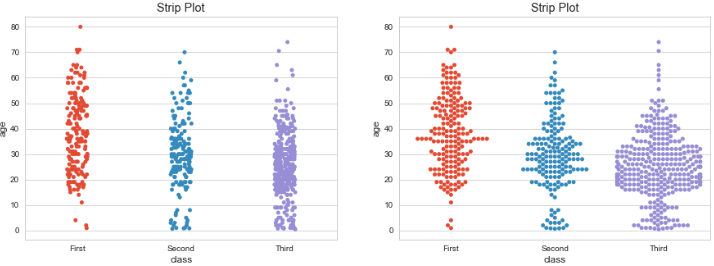
막대 그래프
sns.barplot(): 막대 그래프
# 막대 그래프
# 그래프 객체 생성 (figure에 3개의 서브 플롯을 생성)
fig = plt.figure(figsize=(15, 5))
ax1 = fig.add_subplot(1, 3, 1)
ax2 = fig.add_subplot(1, 3, 2)
ax3 = fig.add_subplot(1, 3, 3)
sns.barplot(x='sex', y='survived', data=titanic, ax=ax1)
sns.barplot(x='sex', y='survived', hue='class', data=titanic, ax=ax2)
# hue='class' : 색상('등급_class') 별로 구분해서 표시
sns.barplot(x='sex', y='survived', hue='class', dodge=False, data=titanic, ax=ax3)
# dodge: 누적 출력
# 차트 제목 표시
ax1.set_title('titanic survived - sex')
ax2.set_title('titanic survived - sex/class')
ax3.set_title('titanic survived - sex/class(stacked)')
plt.show()
빈도 그래프
sns.countplot(): 빈도 그래프- 각 범주에 속하는 데이터 개수를 막대 그래프로 나타냄
dodge=False: 축 방향으로 분리하지 않고 누적 그래프 출력
# countplot()
# 그래프 객체 생성 (figure에 3개의 서브 플롯을 생성)
fig = plt.figure(figsize=(15, 5))
ax1 = fig.add_subplot(1, 3, 1)
ax2 = fig.add_subplot(1, 3, 2)
ax3 = fig.add_subplot(1, 3, 3)
# 기본 설정
sns.countplot(x='class', palette='Set1', data=titanic, ax=ax1)
# hue 옵션에 'who' 추가
sns.countplot(x='class', hue='who', palette='Set2', data=titanic, ax=ax2)
# dodge=False 옵션 추가
sns.countplot(x='class', hue='who', palette='Set3', dodge=False, data=titanic, ax=ax3)
# 차트 제목 표시
ax1.set_title('titanic class')
ax2.set_title('titanic class - who')
ax3.set_title('titanic class - who(stacked)')
plt.show()
박스 플롯/바이올린 그래프
sns.boxplot(),sns.violinplot(): 박스 플롯/바이올린 그래프- 데이터가 퍼져 있는 분산의 정도를 정확하게 알기 어려움
- 커널 밀도 함수 그래프를 y축 방향에 추가
# box violin
# 그래프 객체 생성 (figure에 4개의 서브 플롯을 생성)
fig = plt.figure(figsize=(15, 10))
ax1 = fig.add_subplot(2, 2, 1)
ax2 = fig.add_subplot(2, 2, 2)
ax3 = fig.add_subplot(2, 2, 3)
ax4 = fig.add_subplot(2, 2, 4)
# 박스 그래프 - 기본값
sns.boxplot(x='alive', y='age', data=titanic, ax=ax1)
# 색상(hue) 별로 구분, boxplot 그리기
sns.boxplot(x='alive', y='age', hue='sex', data=titanic, ax=ax2)
# 박스 그래프 - 기본값
sns.violinplot(x='alive', y='age', data=titanic, ax=ax3)
# 바이올린 그래프 - hue 변수 추가
sns.violinplot(x='alive', y='age', hue='sex', data=titanic, ax=ax4)
plt.show()
조인트 그래프
sns.jointplot(): 조인트 그래프- 산점도를 기본으로 표시하고, x-y축에 각 변수에 대한 히스토그램 동시에 보여줌
- 두 변수의 관계와 데이터가 분산되어 있는 정도를 한눈에 파악하기 좋음
# Seaborn 제공 데이터셋 가져오기
titanic = sns.load_dataset('titanic')
# 스타일 테마 설정 (5가지: darkgrid, whitegrid, dark, white, ticks)
sns.set_style('whitegrid')
# 조인트 그래프 - 산점도(기본값)
j1 = sns.jointplot(x='fare', y='age', data=titanic)
# 조인트 그래프 - 회귀선
j2 = sns.jointplot(x='fare', y='age', kind='reg', data=titanic)
# 조인트 그래프 - 육각 그래프
j3 = sns.jointplot(x='fare', y='age', kind='hex', data=titanic)
# 조인트 그래프 - 커널밀도함수
j4 = sns.jointplot(x='fare', y='age', kind='kde', data=titanic)
# 차트 제목 표시
j1.fig.suptitle('titanic fare - scatter', size=15)
j2.fig.suptitle('titanic fare - reg', size=15)
j3.fig.suptitle('titanic fare - hex', size=15)
j4.fig.suptitle('titanic fare - kde', size=15)
plt.show()
조건을 적용하여 화면을 그리드로 분할하기
sns.FacetGrid()- 행, 열 방향으로 서로 다른 조건을 적용하여 여러 개의 서브 플롯 만듦
- 각 서브 플롯에 적용할 그래프 종류를
map()메소드를 이용하여 그리드 객체에 전달
# 조건을 적용, 화면 그리드 분할
plt.style.use('ggplot')
g = sns.FacetGrid(data=titanic, col='who', row='survived') # 조건
g.map(plt.hist, 'age')
plt.show()
이변수 데이터의 분포
sns.pairplot(): 이변수 데이터의 분포- 인자로 전달되는 데이터프레임의 열(변수)을 두 개씩 짝을 지을 수 있는 모든 조합
titanic_pair = titanic[['age', 'pclass','fare']]
sns.pairplot(titanic_pair)
plt.show()
3) Folium 라이브러리 - 지도 활용
Map()- 지도 객체를 만들 수 있음
- 지도 화면 - 줌(zoom) 기능, 화면 이동(scroll)
- 웹 기반 지도 >> 웹 환경에서만 지도를 확인할 수 있음
save()메소드를 적용하여 HTML 파일로 저장 > 웹브라우저에서 파일을 열어서 확인해야 함- Jupyter Notebook 웹 기반 IDE에서는 바로 확인 가능
import folium
seoul_map = folium.Map(location=[37.55, 126.98], zoom_start=12)
seoul_map.save('./seoul.html')
지도 스타일 적용하기
Map(tiles=''): 지도에 적용하는 스타일 변경하여 지정 가능folium.Map(tiles='Stamen Terrain')- 산악 지형 등의 지형이 선명하게 드러남
# 서울 지도 만들기
seoul_map_terrain = folium.Map(location=[37.55,126.98],
tiles='Stamen Terrain',
zoom_start=12)
seoul_map_terrain
folium.Map(tiles='Stamen Toner')- 흑백 스타일로 도로망을 강조해서 보여줌
seoul_map_toner = folium.Map(location=[37.55,126.98],
tiles='Stamen Toner',
zoom_start=12)
seoul_map_toner
지도에 마커 표시하기
folium.Marker(): 위도, 경도 정보 전달popup마커를 클릭했을 때 팝업창에 표시해주는 텍스트 넣을 수 있음
for name, lat, lon in zip(df.index, df.위도, df.경도):
print(name, lat, lon)
folium.Marker([lat, lon], popup=name).add_to(seoul_map_terrain)
seoul_map_terrain
# 대학교 위치정보를 CircleMarker로 표시
for name, lat, lng in zip(df.index, df.위도, df.경도):
folium.CircleMarker([lat, lng],
radius=10, # 원의 반지름
color='brown', # 원의 둘레 색상
fill=False,
fill_color='white', # 원을 채우는 색
fill_opacity=0.8, # 투명도
popup=name
).add_to(seoul_map)
seoul_map
지도 영역에 단계구분도(Choropleth Map) 표시하기
# 단계구분도
import json
file_path = '경기도인구데이터.xlsx'
df = pd.read_excel(file_path, index_col='구분')
df.columns = df.columns.map(str)
# 경기도 시군구 경계 정보 geo-json 파일 불러오기
geo_path = '경기도행정구역경계.json'
geo_data = json.load(open(geo_path, encoding='utf-8'))
# 경기도 지도 만들기
g = folium.Map(location=[37.5502,126.982],
tiles='Stamen Terrain',
zoom_start=10)
# 출력할 연도
year = '2017'
# Choropleth 클래스로 단계구분도 표시하기
folium.Choropleth(geo_data=geo_data, # 지도 경계
data=df[year], # 설정한(표시하고자 하는) 데이터
columns=[df.index, df[year]], # 열 지정
fill_color='PuBu',
fill_opacity=0.7,
line_opacity=0.3,
threshold_scale=[10000,100000,300000,500000,700000],
key_on='feature.properties.name'
).add_to(g)
g